IRELAND
Dublin

Dublin
Dublin
Dublin is the vibrant capital of Ireland with many different faces. The Liffey River flows right through this medieval town, which was founded by the Vikings around 841. This river serves as a convenient landmark for those visiting the city. Dublin is also the city with perhaps more pubs per capita than anywhere else and it is the city of Guinness beer. So what you should definitely do when you are in Dublin is to drink an Irish beer in the pub.
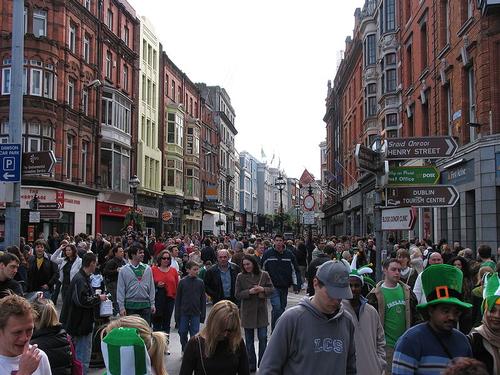 Dublin shopping (Grafton Street) Photo: Robzle in the public domain
Dublin shopping (Grafton Street) Photo: Robzle in the public domain
| advertisement |
| Hotels Dublin |
Location
The island of Ireland is located to the west of Great Britain. The Irish Sea lies between Ireland and the United Kingdom and Dublin is the capital of Ireland. The city is located on the east coast of the island and has an area of approximately 115 km². Dublin is divided in two by the Liffey. Today, more than 500,000 people live in Dublin.
Weather
Dublin, like the rest of Ireland, has a moderate maritime climate. This climate is caused by the Warm Gulf Stream (North Atlantic Drift) in the Atlantic Ocean. In Dublin, the winters are mild and the summers relatively cool. Ireland is a fairly small island and there are hardly any climate differences between the different regions. Below are some average weather features in Dublin.
January:5 °C, 2 hours of sunshine per day and 19 days of precipitation per month
February:5 °C, 3 hours of sunshine per day and 17 days of precipitation per month
March:6 °C, 4 hours of sunshine per day and 15 days of precipitation per month
April:8 °C, 5 hours of sunshine per day and 17 days of precipitation per month
May:10 °C, 6 hours of sunshine per day and 16 days of precipitation per month
June:14 °C, 6 hours of sunshine per day and 15 days of precipitation per month
July:20 °C, 5 hours of sunshine per day and 14 days of precipitation per month
August:21 °C, 5 hours of sunshine per day and 16 days of precipitation per month
September:14 °C, 4 hours of sunshine per day and 16 days of precipitation per month
October:11 °C, 3 hours of sunshine per day and 18 days of precipitation per month
November:7 °C, 2 hours of sunshine per day and 17 days of precipitation per month
December:5 °C, 2 hours of sunshine per day and 18 days of precipitation per month
History
Dublin may well have existed in the 2nd century AD. However, it is not until the 9th century AD that we have more solid evidence of the existence of a settlement. In 841, the Vikings established a permanent settlement in the territory of Dublin. The name Dublin comes from the word dubh linn which means something like dark pool in the gaelic. After the Anglo-Norman invasion in the 12th century and during the Middle Ages, Dublin was the center of power and an important trading city.
In 1592, Queen Elizabeth I granted a charter to create a new university. Trinity College opened in 1594, and the city became a place of learning and culture.
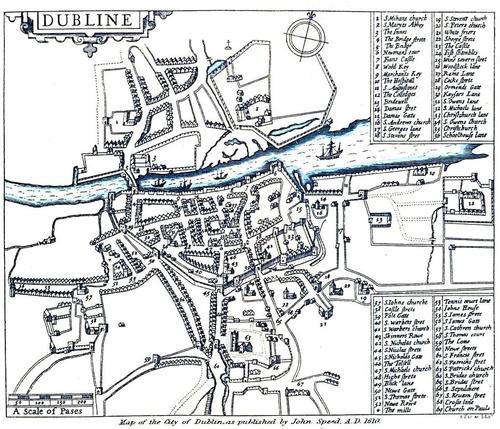 Dublin in 1610Photo: Public Domain
Dublin in 1610Photo: Public Domain
The 17th century was a booming period and Dublin was considered one of the richest cities in Europe during the French Revolution. Many new buildings were built in Georgian style. The arrival of Protestant immigrants from Europe helped with Dublin's prosperity, bringing much needed skills to boost the wool and linen industry.
In the 18th century, Dublin was a city of about 60,000 people. It was seen as a respectable place, home to the middle and upper classes. Dublin Castle was rebuilt in the distinctive architectural styles of the time. Ireland's original Parliament House, later the home of the Bank of Ireland, is a good example of Georgian architecture. Hospitals were established and parks were created.
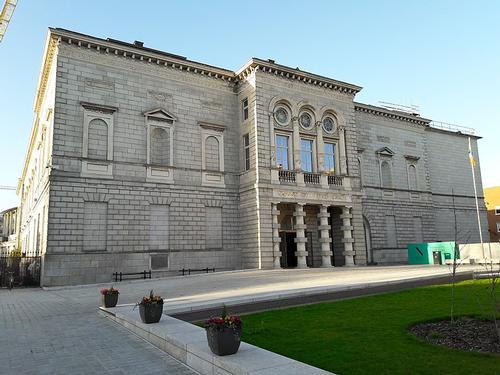 National Gallery of Ireland DublinPhoto: NTF30 CC 4.0 International no changes made
National Gallery of Ireland DublinPhoto: NTF30 CC 4.0 International no changes made
By the early 19th century, Dublin's population had grown to over 150,000. Notable at this time was the opening of the zoo, the foundation of the Catholic University of Dublin and the opening of the National Gallery of Ireland in 1864. In the late 19th century, Dublin played an important role in the revival of Ireland's Irish language and literature. Famous literary figures associated with the city include the author WB Yeats, who was born in the Sandymount area in 1865, James Joyce studied at University College Dublin (UCD) in 1898.
Dublin was the center of the Easter Revolt in 1916 and became the capital of the Free State and the Republic of Ireland. But Dublin also fell into disrepair. In the sixties many old houses were demolished and new office blocks were built. The booming "Celtic Tiger" economy of the 1990s led to further growth, with many wealthy Dubliners moving to the suburban areas.
Sights
When you visit Dublin you will be truly amazed by the many sights in the city. There are beautiful old buildings in the historic center and authentic medieval streets can be found. In addition, Dublin has beautiful parks and interesting museums. A number of sights will be explained in more detail below.
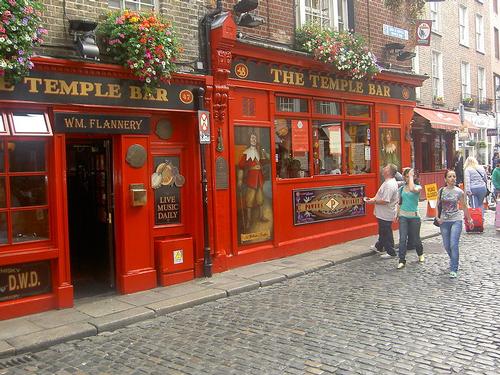 Dublin Temple BarPhoto: Cotton CC 3.0 Unported no changes made
Dublin Temple BarPhoto: Cotton CC 3.0 Unported no changes made
The Temple Bar district is the gastronomic center of Dublin. The neighborhood is on the south side of the Liffey and was first mentioned in 1673. The name of this district in Dublin comes from the Irish rector Sir William Temple who once lived there, or it is derived from London's Temple Bar. Temple Bar is one of the most touristic areas of Dublin. When you think of Dublin, you think of pubs and that's why it's best to go to Temple Bar. The neighborhood is full of cozy pubs where you can taste the real Irish atmosphere. Dublin's Temple Bar is also the place to go for a nice meal in a restaurant or an evening of dancing in a disco.
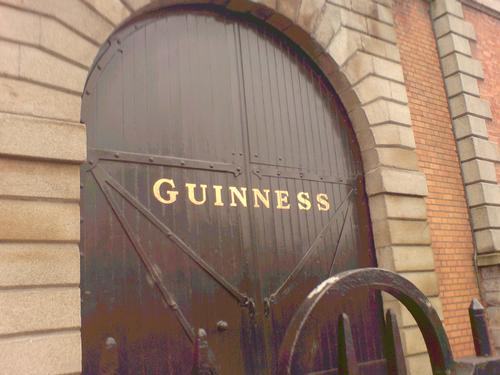 Guiness DublinPhoto: Ijanderson977 in the public domain
Guiness DublinPhoto: Ijanderson977 in the public domain
Just to stick with the theme, the Guiness Brewery, is another fun excursion for visitors to the city of Dublin. Guiness beer is also called black gold. The St. James' Gate Brewery was opened in 1759 and beer is still produced today. In the large walled complex you learn everything about the beer brewing process. As icing on the cake you can enjoy a delicious 'pint of Guiness' in the panorama room. You also have a phenomenal view of Dublin from this room.
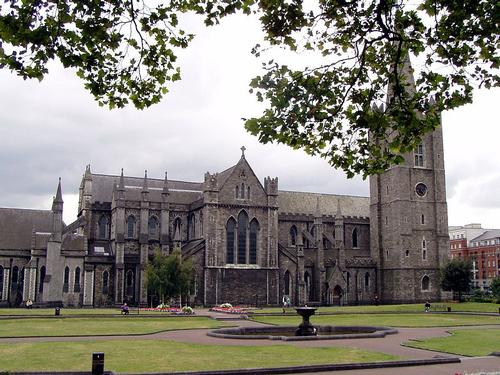 St. Patrick's Cathedral DublinPhoto: Thorsten Pohl Thpohl in the public domain
St. Patrick's Cathedral DublinPhoto: Thorsten Pohl Thpohl in the public domain
St. Patrick's Cathedral in Dublin is the largest church in all of Ireland. The construction of the church started in 1191 and it took no less than 79 years to complete the construction. Today, the cathedral is still the pride of Dublin. The cathedral contains graves of several famous Dublin residents. For example, Jonathan Swift, the author of the world famous book Gulliver's travels, is buried there. Services are still taking place at Dublin's St. Patrick's Cathedral.
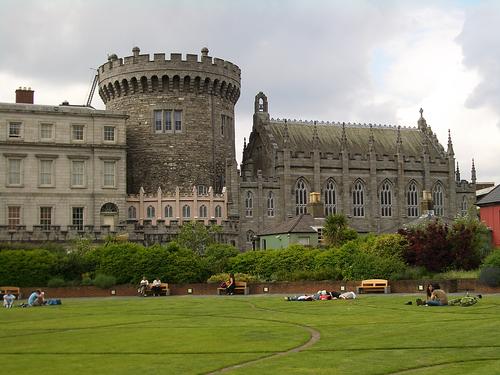 Dublin CastlePhoto: Vmenkov CC 3.0 Unported no changes made
Dublin CastlePhoto: Vmenkov CC 3.0 Unported no changes made
Dublin Castle, a castle from the 13th century, is located in the historic center of the city. The castle was the headquarters of the English government of Ireland for over 700 years. Much of the castle has unfortunately been destroyed, but you can still admire the remains. The castle tower called Record Tower is without doubt the most notable part of what remains of the castle.
One of Europe's finest smaller art museums, the National Gallery of Ireland is the first in a series of significant public buildings on the west side of Merrion Square. With more than 3000 works from the 14th to the 20th centuries, this museum is worth a visit. The paintings are by famous artists such as Monet, Sisley, Pissarro, Rembrandt, Goya and Caravaggio. The new Millennium Wing is a spectacular venue used to host many important international exhibitions.
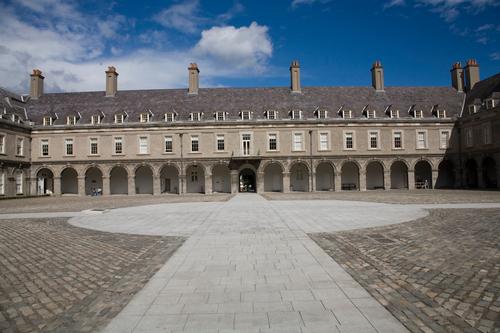 IMMA DublinPhoto: William Murphy CC 2.0 Generic no changes made
IMMA DublinPhoto: William Murphy CC 2.0 Generic no changes made
Founded in 1991, the Irish Museum of Modern Art (IMMA) is located in the beautiful Royal Hospital Kilmainham, which dates back to the late 17th century. IMMA serves as the leading national institution for modern and contemporary art in Ireland and has a permanent collection of approximately 2,000 works, which are regularly changed.
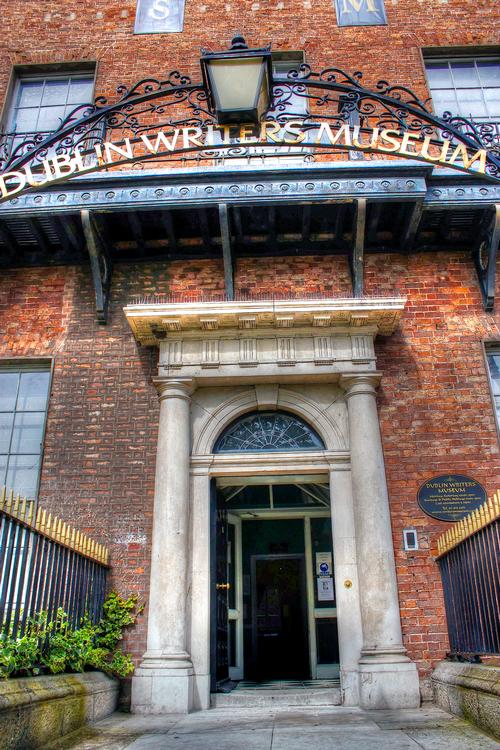 Dublins Writers museumPhoto: Psyberartist CC 2.0 Generic no changes made
Dublins Writers museumPhoto: Psyberartist CC 2.0 Generic no changes made
Ireland is very famous for its many writers and the renowned Writers Museum celebrates it with collections of rare first editions, manuscripts, diaries and letters from WB Yeats, Joyce, Wilde and Beckett. The huge 18th century mansion has been beautifully restored and in the center is a huge drawing room, full of paintings. This includes an 1804 edition of Swift's 'Gulliver's Travels' and a first edition from 1899 of Bram Stoker's 'Dracula'.
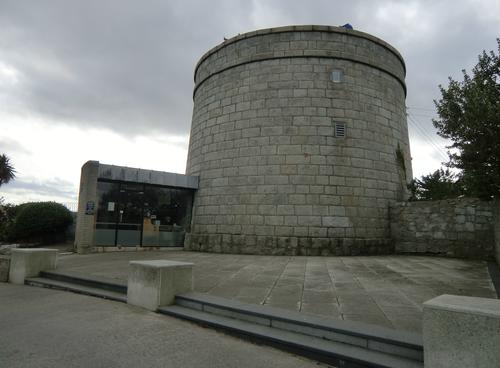 James Joyce Martello Tower DublinPhoto: YvonneM CC 3.0 Unported no changes made
James Joyce Martello Tower DublinPhoto: YvonneM CC 3.0 Unported no changes made
The James Joyce Martello Tower was built in 1804, when Napoleon's invasion was imminent, the tower was one of 34 Martello towers around the Irish coast. They were all demilitarized in the 1860s and this tower now houses the James Joyce museum, which was founded in 1962. The famous writer James Joyce stayed here in 1904 and the exhibition contains many of his first editions and even some of his clothes .
Tips
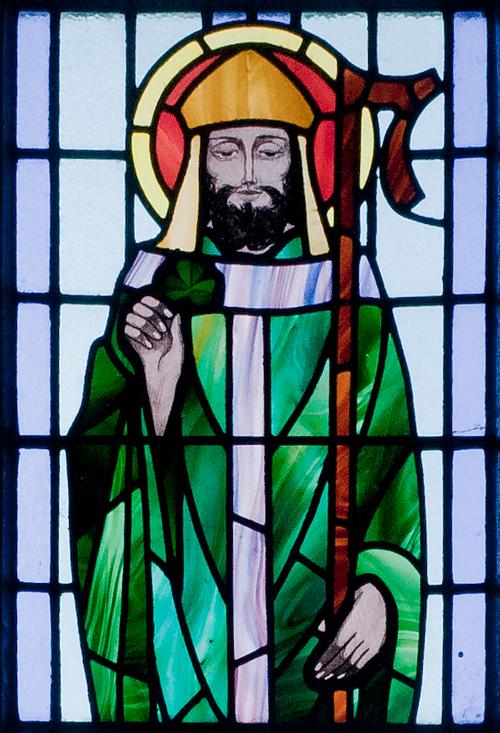 St Patrick with ShamrockPhoto: Andreas F. Borchert CC 3.0 Germany no changes made
St Patrick with ShamrockPhoto: Andreas F. Borchert CC 3.0 Germany no changes made
St. Patrick's Day falls on March 17. On this day, the national patron saint of Ireland, Saint Patrick, is commemorated. A St. Patrick's festival is held in Dublin from March 12 to March 17. During these days, all of Dublin turns green. People wear green clothes and often even the beer is colored green. Green, because Saint Patrick is associated with the clover. It is believed that St. Patrick used a green three leaf clover to convert unbelievers to faith in the Holy Trinity. You can enjoy outdoor concerts, booze, food, fair and parades everywhere on Dublin's St. Patrick's Day in Dublin and throughout Ireland. Spending St. Patrick's Day in Dublin is an unforgettable experience.
Useful links Dublin
BBC Country ProfilesWorld Fact Book Explore all Countries
How to call
Last updated June 2024
Copyright: Team - The World of Info